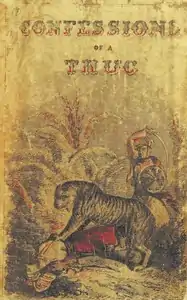Confessions of a Thug (novel)
Confessions of a Thug is an English novel written by Philip Meadows Taylor in 1839 based on the Thuggee cult in British India.[1][2] It was a best-seller in 19th-century Britain, becoming the British Empire's most sensational ethnographic fiction in the first half of the 19th century; its avid readers included Queen Victoria.[3] It was one of the best-selling crime novels of the 19th century, and was the most influential novel about India prior to Rudyard Kipling's Kim (1901).[4] The novel's popularity established the word "thug" in the English language.[5]
 | |
| Author | Philip Meadows Taylor |
|---|---|
| Cover artist | Richard Bentley |
| Country | United Kingdom |
| Language | English |
| Genre | Historical novel |
Publication date | 1839 |
| Media type | Print (Hardback & Paperback) |
| Pages | 552 pp |
Plot
The plot revolves around a fictional anti-hero protagonist, Ameer Ali, a Muslim thug.[6] This book is a tale of crime and retribution in India, beginning in the late 18th century and ending in 1832. The story lays bare the practices of the Thugs, or "deceivers" as they were called, who murdered travellers for money and valuables. This work was originally published in 1839 and reprinted in 1873.
Characters
- Ameer Ali: The novel's protagonist, a Pathan (Pashtun) Muslim adopted and raised by a thug. After becoming a prominent jemadar, he and his father relocate to Jhalone and gain the confidence of the local ruler, Raja Govindrao II.
- The Englishman: Ameer Ali's interlocutor and a stand-in for Phillip Meadows Taylor. His interviews of Ameer Ali provides a frame for the narrative of the novel. The Englishman describes the physical appearance of Ameer Ali in his imprisonment and will occasionally express moral outrage at some part of the tale, or otherwise offer criticism.
- Ismail: The adopted father of Ameer Ali. A respected and high-ranking Muslim thug, he is childless and adopts Ameer Ali. During the first half of the story, Ismail and his family live in a small village near Nagpur.
- Bhudrinath: A Hindu thug and early peer of Ameer Ali. He is an expert in the religious ceremonies of the Thuggee faction.
- Peer Khan: A Muslim thug and another close ally of Ameer Ali. He retires from thuggee to become a fakir.
- Gunesha: A prominent Hindu thug of Ismail's generation. He serves as Ameer Ali's antagonist in the second half of the story.
- Cheetoo: A prominent leader of pindari expeditions. Ameer Ali and several thugs join him as mercenary soldiers.
Historicity
Ameer Ali, the fictional anti-hero protagonist of Confessions of a Thug,[6] is a composite of multiple real-life thugs: Feringhea, Ameer Alee, and Aman Subahdar. Feringhea was a jamadar, or captain, and led many expeditions before turning into a prolific informer for the British.[7] The historical Ameer Alee, who provided the fictional character's name, was a low-ranking thug mentioned only twice by Sleeman in his definitive work.[8] Finally, Aman Subahdar was described by Sleeman as "the foremost thug of his day," but died before the events of the novel conclude. One scene in the novel, in which a thug band led by Ameer Ali suffers a misfortune, is lifted almost word-for-word from Sleeman's book. In the historical version, Aman Subahdar led the expedition.[9] Further, Feringhea and Aman Subahdar were cousins but no such comparable character exists in the novel.
See also
References
- Poovey, Mary (2004-01-01). "Ambiguity and Historicism: Interpreting Confessions of a Thug". Narrative. 12 (1): 3–21. doi:10.1353/nar.2003.0025. ISSN 1538-974X.
- "The SF Site Featured Review: Confessions of a Thug". www.sfsite.com. Retrieved 2016-04-02.
- Pal-Lapinski, Piya (2005). The Exotic Woman in Nineteenth-century British Fiction and Culture: A Reconsideration. University Press of New England. p. 31. ISBN 9781584654292.
- Taylor, Philip Meadows (1998). Confessions of a Thug. Oxford University Press. ISBN 9780192880215.
- Rushby, Kevin (18 January 2003). "The myth and mystery of the oriental criminal". The Guardian.
- Taylor, Meadows (July 1918), "The Confessions of a Thug", The American Journal of Sociology, 24 (1): 115, doi:10.1086/212883
- Sleeman, W. H. S. (1840). Report on the depredations committed by the thug gangs of upper and central India, from the cold season of 1836-37, down to their gradual suppression, under the operation of the measures adopted against them by the supreme government, in the year 1839. Calcutta: G.H. Huttmann. Pages vi, 5-8, 17, 24-26, 42, 46, 49, 61, 64, 67, 75, 110.
- Sleeman, W. H. S. (1840). Page 63.
- Sleeman, W. H. S. (1840). Page 386.
External links
| Wikisource has original text related to this article: |
- Imperial deceivers, The Guardian
- Scanned book at Google Books
- Confessions of a Thug at Google Books
- Confessions of a Thug at Project Gutenberg
